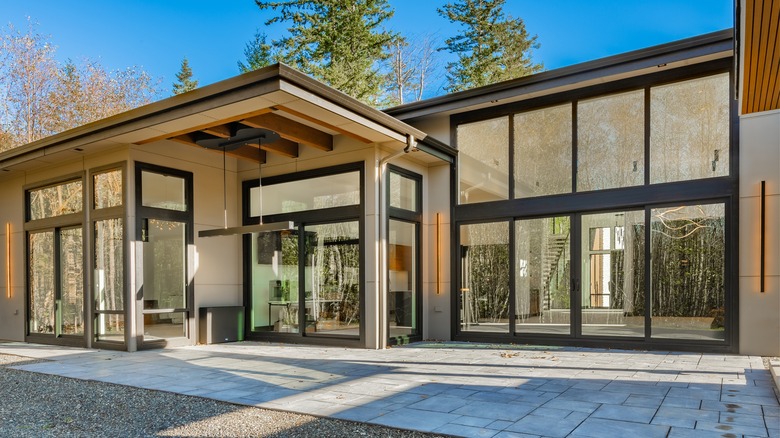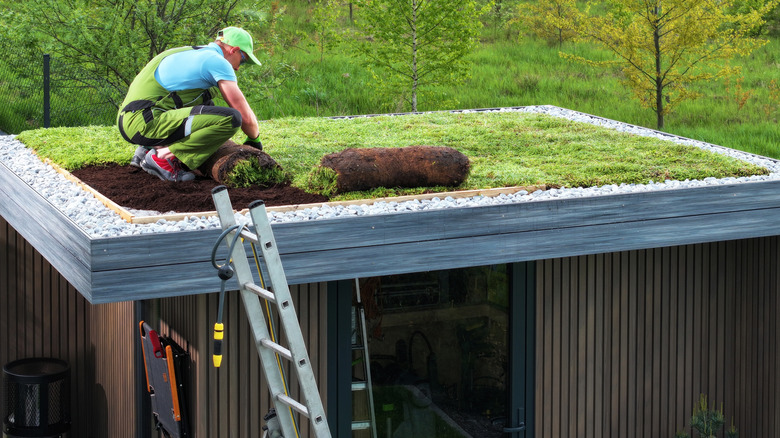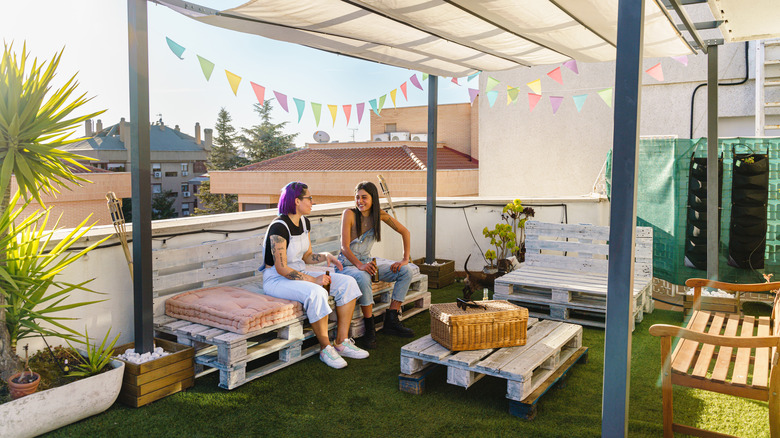Why Do So Many Modern Homes Have Flat Roofs?
The house one may conjure in their mind's eye after hearing the phrase "modern home" will probably include a few key features like giant floor-to-ceiling windows and sleek plaster walls. While these architectural elements are often associated with luxury, modern homes also usually have a trait that is more akin to affordably made commercial buildings: flat roofs. At first blush, it's a bit strange to realize that some high-end modern homes have the same roof design as a nondescript office building. However, this similarity simply comes down to cheaper, easier-to-install building materials that became more prevalent during the same time that modern homes were first being designed. And unlike other modern home trends that won't age well, flat roofs are a lot more likely to stand the test of time.
Before the 19th century, most roofs were made of organic materials like wood, stone shingles, or thatched straw. While plenty sturdy, these materials aren't waterproof, so roofs were often pitched or sloped to help rain and snow drain away. Once the world became more industrialized, new materials like steel and concrete made differently structured roofs, such as flat roofs, a much more viable option. By the beginning of the United States' modern architecture movement in the 1930s, synthetic materials were widely available, allowing residential structures to benefit from their affordability, flexibility, and unique aesthetic possibilities.
Flat roofs are a cheap way to add architectural interest
Even though flat roofs can instantly make a home look more opulent and intentionally designed, they take a fraction of both the time and the money it would take to install a traditional pitched roof. That's because you'll need less material to finish the project and the roofers can more easily move around on a flat roof. And once the roof is done, the level surface will make any additional maintenance a breeze.
For many people, the best reason to install a flat roof is the instantaneous upscale effect it will have on your house's aesthetic. Whether you're going for a minimalist, modern, contemporary vibe, or you want to embrace the rustic feel of a ranch-style home, a flat roof can make your property look that much more fantastic. If you're not quite ready to raise the roof, you could also try the easiest way to raise your home's curb appeal.
Another benefit of a flat roof is the extra square footage it can give you. Depending on your space, a rooftop can be a great space for a garden or patio, or even a hot tub! If you have a smaller home or live somewhere without a lot of outdoor space, putting in a flat roof that doubles as a living area can be especially useful.
Not every homeowner needs a flat roof
The major downside to flat roofs is their inability to effectively drain away large amounts of precipitation. Therefore, if you live in an area that sees a lot of rain or snow, you will probably be better off with a pitched roof. Even if your home doesn't get a lot of extreme weather, flat roofs can still be problematic when it comes to excess moisture. A good roofer and the best materials can help prevent issues like leaks, but flat roofs will almost always collect water, which can cause structural damage over time. The only way to avoid this problem is to install a flat roof slightly on a slope, but that means you likely won't be able to use the roof safely as an extra living area.
Flat roofs are typically best in regions where they've been traditionally included in the architecture, such as the flat adobe homes made by the American Southwest's Indigenous Pueblo people. In these areas, flat-roofed homes can actually be a sustainable choice since they provide a great base for solar panels and rain collection systems. There's no doubt that flat roofs look stunning, but they still have their pros and cons. If you need help making up your mind, check out our guide on how to pick the best roof for your home.


